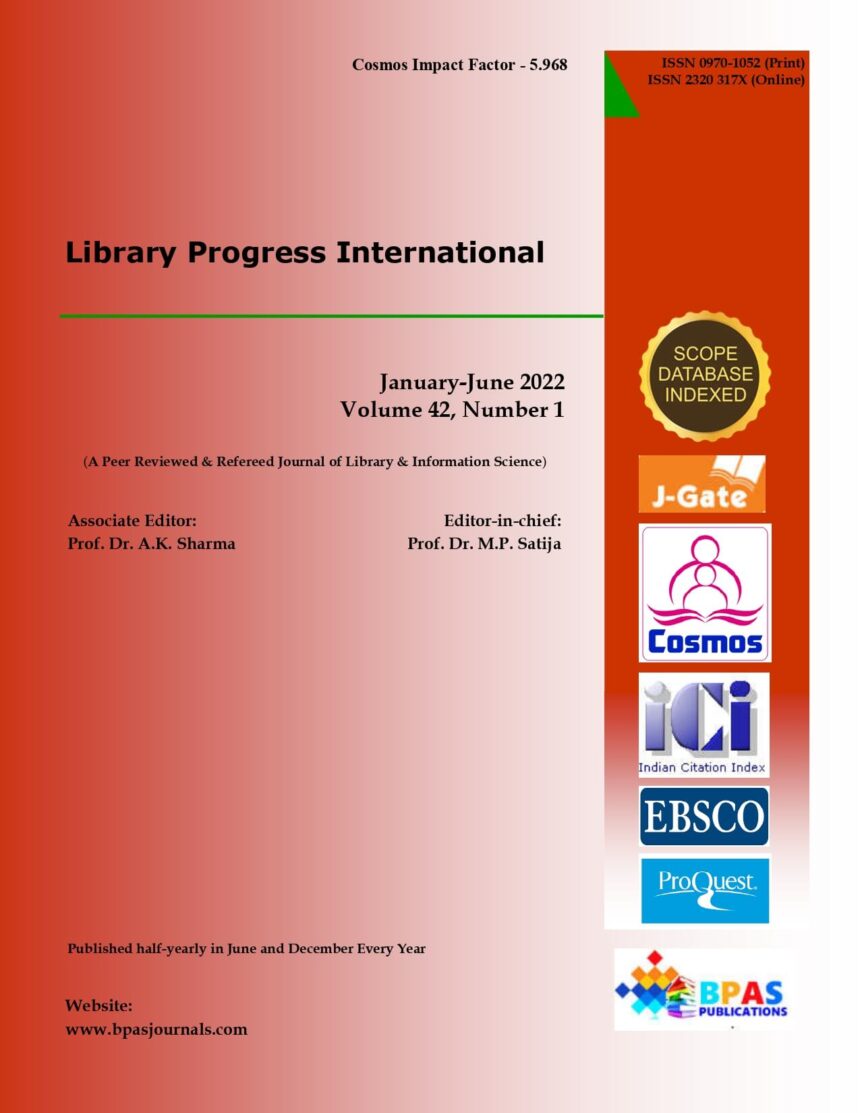Tracking the Impact and Trends in Water Resources Research in India: A Scientometric Analysis
DOI:
https://doi.org/10.48165/bpas.2023.43.2.5Keywords:
Water Resources, Scientometric Evaluation, Network Visualization, Research Publications, Web of Science, IndiaAbstract
This study intends to analyse the research trends, growth, and collaboration patterns in the field of Water Resources in India. The source for the data collection is the Web of Science (WoS) Core Collection Database. A total of 797 publications published during the period from 2016 to 2021 satisfying these search criteria were pulled out to perform further analysis. This study revealed that Water Resources Management is the most productive journal with 26 articles (3.26%), followed by Arabian Journal of Geosciences 22 (2.76%), Environmental Earth Sciences 21 (2.63%) publications got 2nd and 3rd rank respectively. the year 2020 highest number of articles 236 (29%) were published on water resources followed by the year 2019 with 149 (18.69%).The Most productive author Malik, Anurag from Punjab Agricultural University is in the top position with 16 (2.007%) published articles. 177 (22.2%) of the total publication have two authored contributions taking the first position. Indian Institute of Technology Bombay published the highest number of articles i.e., 48 (6.02%) occupy 1st rank. Department of Science & Technology India funded 6.27%of published articles in the field of Water Resources Research.USA has the highest number of collaborative research work with India. China comes second with AFI value of 8.50. The Internationalization Index of Indian Water Resources literature is 73.77.Co-operative efforts show that there are 580 scientific links created between other countries, depicting most publications collaborated with authors from more than two countries.
Downloads
References
Chen, D., Bi, B.,Luo, Z. H., Yang, Y. W., Webber, M., & Finlayson, B. (2018). A scientometrics review of water research on the Yangtze River. Applied Ecology and Environmental Research, 16(6), 7969-7987.
Chuang, K. Y., Wang, M. H. & Ho, Y. S. (2011). High-Impact papers presented in the subject category of Water Resources in the essential science indicators database of the Institute for scientific information. Scientometrics, 87, 551–562.
Fu, H. Z., Wang, M. H. & Ho, Y. S. (2012). Mapping of drinking water research: A bibliometric analysis of research output during 1992–2011. Science of the Total Environment, 443, 757–765.
Ho, Y. S. (2008). Bibliometric analysis of biosorption technology in water treatment research from 1991 to 2004. International Journal of Environment and Pollution, 34(1-4), 1-13.
Hu, J., Ma, Y., Zhang, L., Gan, F. & Ho, Y. S. (2010). A historical review and bibliometric analysis of research on lead in drinking water field from 1991 to 2007. Science of the Total Environment, 408(7), 1738–1744.
Husain, S., Raza, A. & Gul ,R. (2018). Literature on river Ganga: A Bibliometric analysis. Journal of Indian Library Association, 54(1).
Khan, M. A. & Ho, Y. S. (2011). Arsenic in Drinking Water: A Review on Toxicological Effects, Mechanism of Accumulation andRemediation. Asian Journal of Chemistry. 23(5) 1889-1901.
Qian, F., He, M., Song, Y., Tysklind, M. & Wu, J. A. (2015). Bibliometric analysis of global research progress on pharmaceutical wastewater treatment during 1994–2013. Environmental Earth Science, 73(9), 4995–5005.
Ramaswamy, P. R. (2003). Management of Water as a National Resource for Sustainable Development. Indian Journal of Public Administration, 49(3), 369-373.
Singh, G., Mittal, R. & Ahmad, M. (2007). A bibliometric study of literature on digital libraries. The Electronic Library. DOI: 10.1108/02640470710754841 ·
Singh, H.&Jaiswal, B. (2023). Scientometric Evaluation of Trends and Global Characteristics of Published Literature on Archaeology. Changing Landscape of LIS Education and Research (Prof. H.N. Prasad Festschrift Volume). 2023. Shree Publishers & Distributors; New Delhi.311-322.
Sun, J. & Yuan, B. J. (2020). Mapping of top papers in the subject category of Water Resources based on the Essential Science
**********
Indicators. Annals of Library and Information Studies,67, 90-102.
Wambu, E. W. & Ho, Y. S. (2016). A bibliometric analysis of drinking water research in Africa. African Journals Online (AJOL), 42(4).
Wang, Y., Xiang, C., Zhao, P., Mao, G. & Du, H. (2016). A bibliometric analysis for the research on river water quality assessment and simulation during 2000– 2014.Scientometric, 108(3), 1333–1346.
Wanga, M. H., Li, J. & Ho, Y. S. (2011). Research articles published in water resources journals: A Bibliometric analysis. Desalination and Water Treatment. 28,353-365
Zare, F., Elsawah, S., Iwanaga, T., Jakeman, A. J. & Pierce, S. A. (2017). Integrated water assessment and modelling: A bibliometric analysis of trends in the water resource sector. Journal of Hydrology, 552, 765–778.
Zhang, L., Li, S., Loaiciga, H. A., Zhuang, Y. & Du, Y. (2015). Opportunities and challenges of Interbasin water transfers: a literature review with bibliometric analysis, Scientometrics, 105(1), 279–294.

